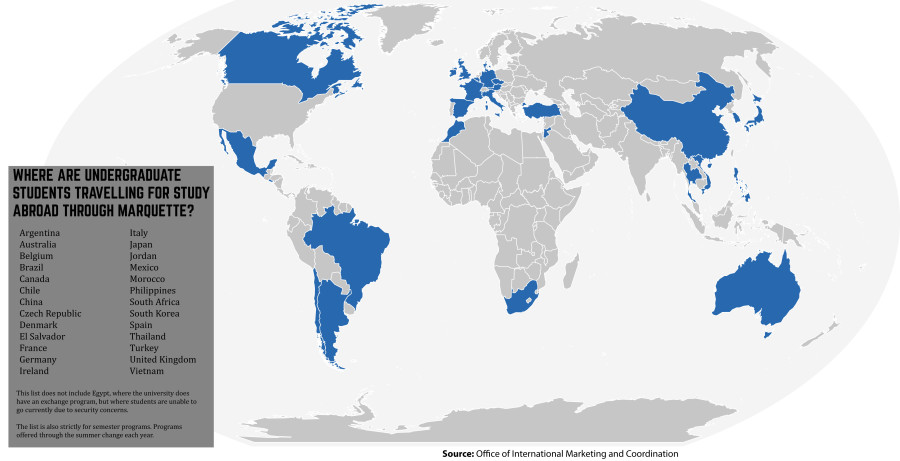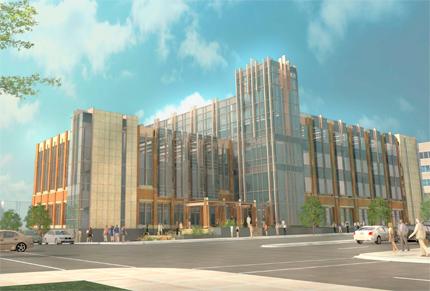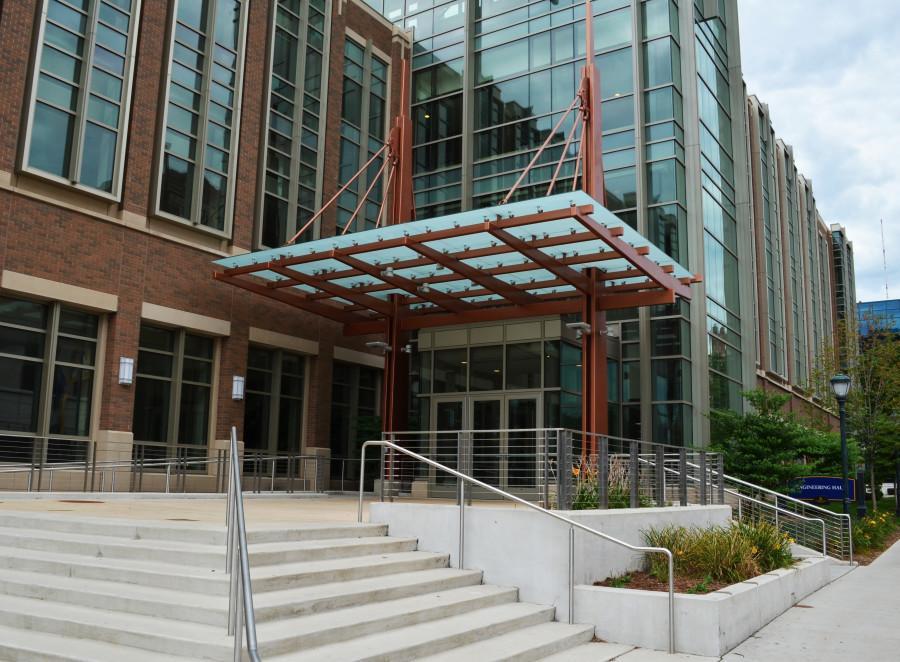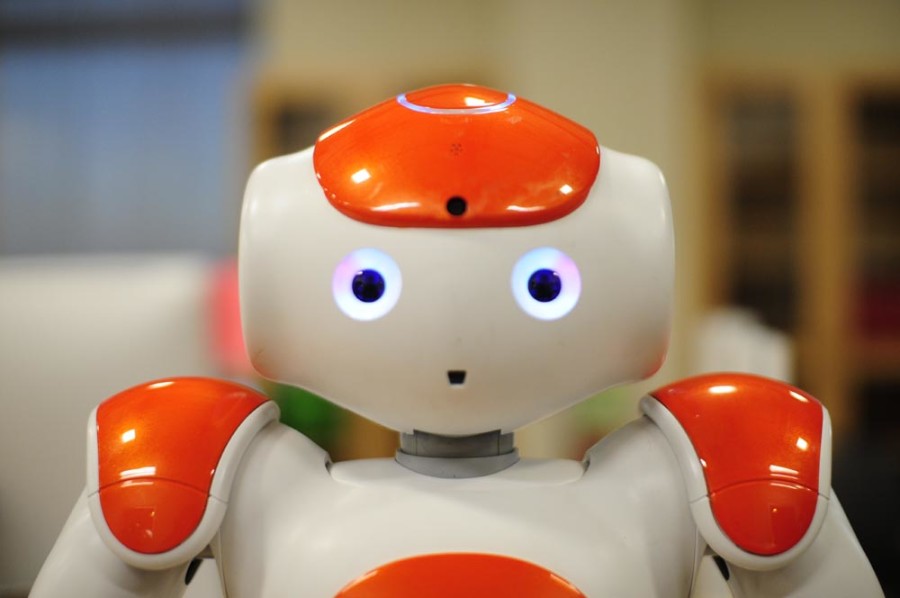
An unexpected return awaited a Marquette team as it hopped off the plane and headed back to campus from a long journey back from João Pessoa, Brazil. The team put forth quite an effort on the trip, and though it was held scoreless in competition, chins were up and cheers awaited as it entered Engineering Hall.
The cheers were not for the players, though. The cheers were for the group that made them.
This was the scene as Marquette’s Team MU-L8 of the Humanoid Engineering and Intelligent Robotics Lab returned from RoboCup 2014, an annual event that brings together groups from around the world to share knowledge of humanoid robotics with a robotic soccer tournament. The Marquette students built two robots – named Sunny and Forrest – to compete against other robot tandems from around the world.
The project was a long time in the making.
Two years ago, Andrew Williams moved from Atlanta to Milwaukee to serve as the chair of electrical & computer engineering at Marquette. A few months into the job, he and some students created the Humanoid Engineering & Intelligent Robotics Lab and thus began a year-and-a-half long journey that brought them to Brazil.
Qualifying for RoboCup 2014 was one of the initial goals for the HEIR Lab. The overall goal is to create humanoid robots that help children with health and education and also create rehabilitating technology for those injured or with disabilities.
But to do this, the group needed to understand the technology behind it all and building a robot for a robotic soccer competition was a creative, unique way to accomplish this.
RoboCup is hosted annually to bring together the best minds in the world to collaborate and showcase robots from every corner of the globe. It debuted in 1997 with the goal of having a humanoid team face the 2050 World Cup champion.
At the same time this year’s World Cup concluded in early July, RoboCup teams made final preparations for their international soccer tournament. Using the internationally-recognized language of soccer, the organization is able to bring together teams from universities from all over the world.
To qualify, the HEIR Lab built a functioning robot to be eligible for RoboCup. Sunny, the first MU-L8 humanoid robot, was born and, after its specifications and dimensions were approved in March, the team officially qualified for the event.
However, there was still a long way to go because Sunny required a teammate to mind the net.
“A year and a half ago it was just a vision and a dream (to compete at RoboCup),” Williams said. “Even back in March when we qualified we had no guarantee that we could raise the money to build our second robot and raise the $50,000 to continue the research to go to Brazil.”
The lab raised funds through a Marquette-sponsored, crowd-sourcing campaign through indiegogo.com, as well as from alumni, the engineering department, GE Healthcare, Milwaukee Tool, Rockwell Automation and Sterling Engineering.
With the funds raised, the HEIR Lab built Forrest, the second MU-L8 humanoid robot and goalie for the team. Once the team tested the software and logged hours of practice, it was time to head to Brazil. After the 5,000-mile trek, the team landed and the HEIR Lab’s original goal was about to become a reality.
“It was nice to see an end result to one of the many goals of the HEIR Lab, which was to qualify and compete in João Pessoa for RoboCup,” said John Williams, a junior in the College of Arts & Sciences and undergraduate assistant in the HEIR Lab. “As a kid I would think about doing cool things like traveling the world or making robots but now that it’s actually happening I will remember this experience forever.”
Team MU-L8 did run into some problems. On the second day, Sunny’s battery sparked, temporarily setting a small fire. No damage was done but the team learned that something was wrong with Sunny with only a day left until competition.
The fire was put out and the problem was solved, but even fully functioning, the robots are not superstar athletes.
“As a human team, we operated as a well-oiled machine,” Carey said. “The robots were a different story. Our goalie wasn’t able to move, so all he did was stand there and watch the ball. The attacker wasn’t able to take more than five consecutive steps without falling over and had to be pulled off to the side of the field as a result, attempting to rejoin the action every 30 seconds.”
Team MU-L8 struggled playing against experienced teams that had robots that could even stand up by themselves. But simply having the robots walk is tremendous for a first time RoboCup participant, Andrew Williams was told.
“Our performance can be summed up by one of our competitors, the eventual champions’ this year (Baset from Iran), comments to us,” Williams said. “She said that five years ago when they tried to compete, they couldn’t even get their robot to stand up. She said that we had done so much better than they had when they started.”
In the first match, Team MU-L8 fought to a 0-0 draw against Brazil. The second and third match saw more scoring, but not from Team MU-L8, with a 4-0 loss to Parand Teen, an experienced team from Iran, and a 10-0 loss to 2013 champion NimbRo from Germany. However, against Parand Teen, MU-L8’s robot, Forrest, made the first saves of its career.
The final game of day two ended Team MU-L8’s two-game losing streak with a 0-0 draw against the Canada/Iran team, but that was the end of the road for Marquette as the team failed to qualify for the semi-finals. But Andrew Williams still said the team was proud of many of its accomplishments.
“We got a lot of compliments on the design of our robot ranging from beautiful to amazement that we were able to 3D print our robot,” Williams said. “Our robot made history in the RoboCup teen sized humanoid league as being the first almost fully 3D printed robot to successfully compete. I say ‘almost’ because our robot’s torso was made out of aluminum for added reinforcement.”
While most robots can barely stand in their first Robocup appearance, Sunny and Forrest were able to track the ball, and Sunny was able to walk, if only briefly, and even attempted to kick the ball. Sunny and Forrest’s social intelligence also drew attention from fellow competitors.
Most teams focused more on the technical aspects, but Marquette’s team wanted to have a socially intelligent robot – a robot that can interact with people. Sunny and Forrest’s faces are composed of a Droid smartphone and using the SMILE app, which was developed by Elise Russell, a graduate student in the College of Engineering and in the HEIR lab. It made them capable of reacting situationally to the game, which was a capability no other team had.
The team is looking to build on its success. In addition to preparing for next year’s RoboCup in China, the group hopes to build an MU-L8 2.0 version of its robot to potentially sell to other universities. The plan includes improving the walk engine and even completely redesigning the humanoid skeleton.
For now, though, the team is still appreciating its experience in Brazil.
“The experience goes way beyond the technical challenge,” Andrew Williams said. “It opened our students’ eyes to a whole new global community of technology pioneers in the middle of a rich cultural experience in Brazil.”







